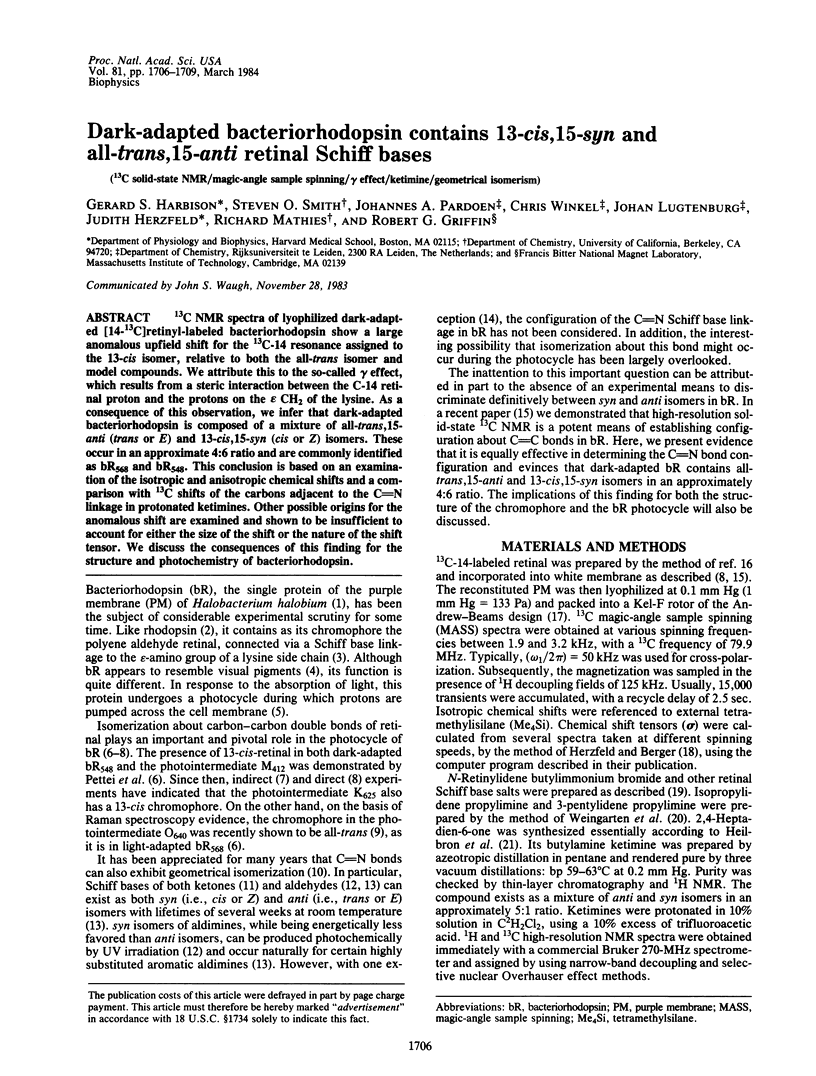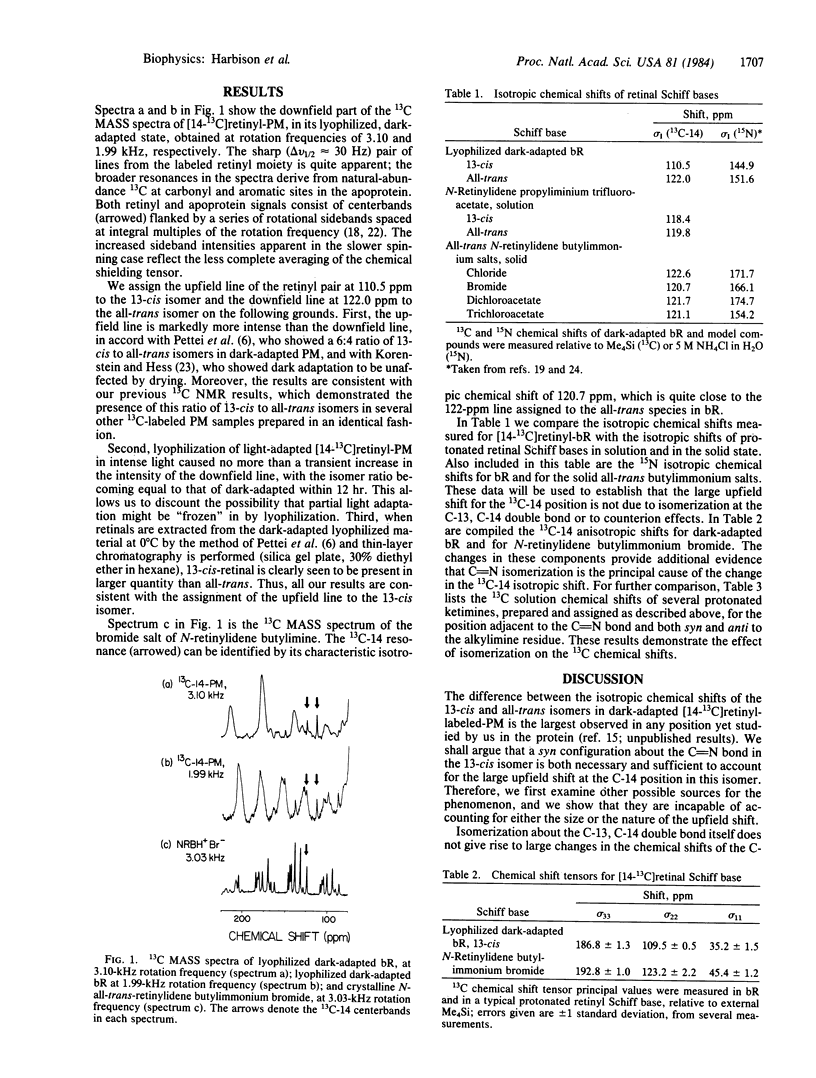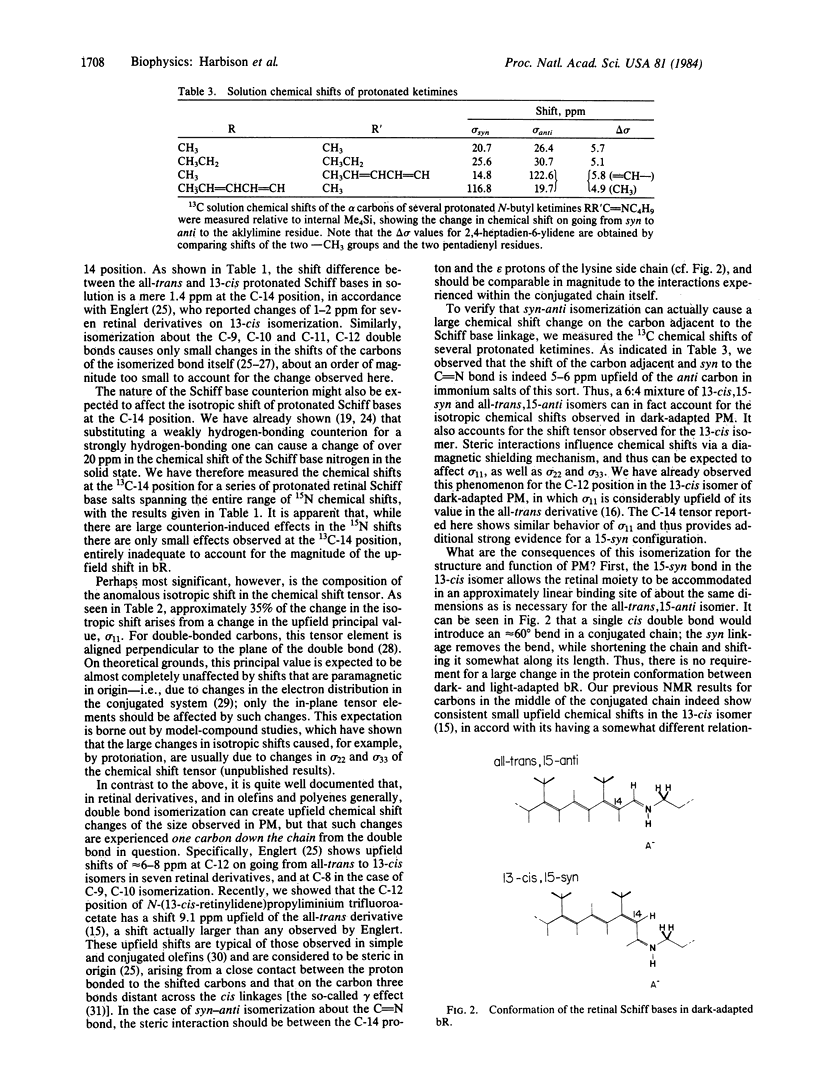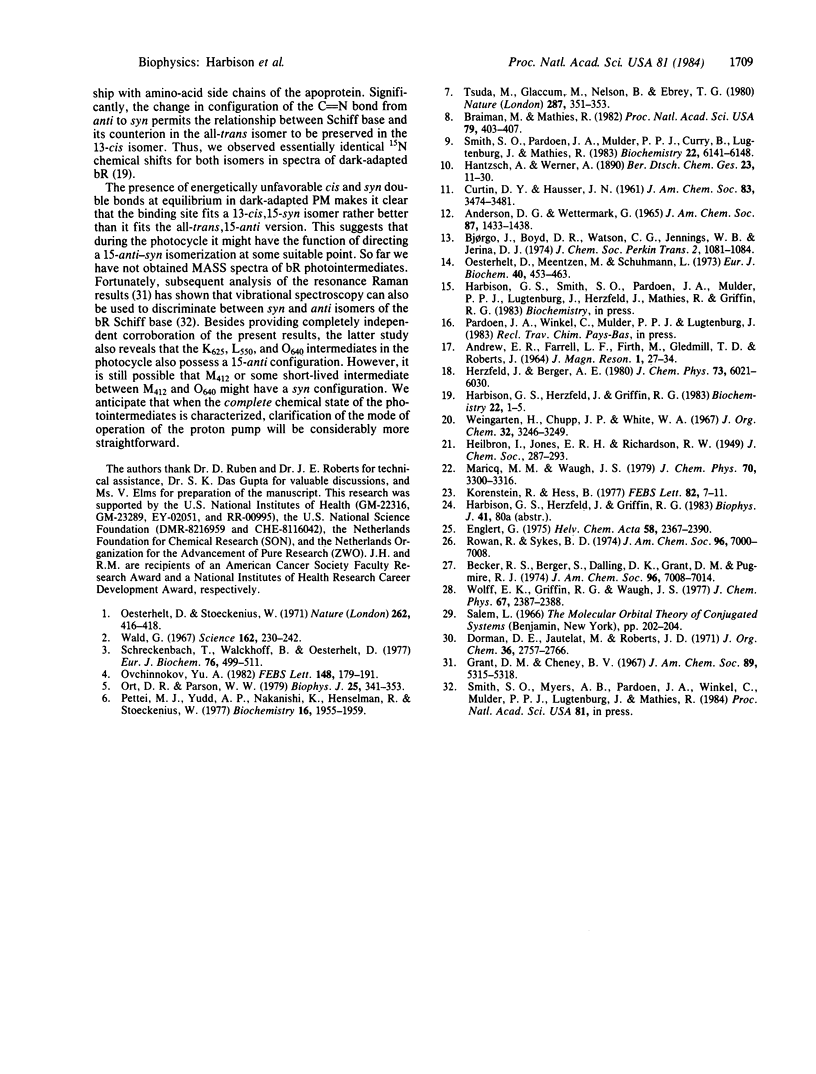Abstract
13C NMR spectra of lyophilized dark-adapted [14-13C]retinyl-labeled bacteriorhodopsin show a large anomalous upfield shift for the 13C-14 resonance assigned to the 13-cis isomer, relative to both the all-trans isomer and model compounds. We attribute this to the so-called gamma effect, which results from a steric interaction between the C-14 retinal proton and the protons on the epsilon CH2 of the lysine. As a consequence of this observation, we infer that dark-adapted bacteriorhodopsin is composed of a mixture of all-trans, 15-anti (trans or E) and 13-cis, 15-syn (cis or Z) isomers. These occur in an approximate 4:6 ratio and are commonly identified as bR568 and bR548. This conclusion is based on an examination of the isotropic and anisotropic chemical shifts and a comparison with 13C shifts of the carbons adjacent to the C = N linkage in protonated ketimines. Other possible origins for the anomalous shift are examined and shown to be insufficient to account for either the size of the shift or the nature of the shift tensor. We discuss the consequences of this finding for the structure and photochemistry of bacteriorhodopsin.
Full text
PDF



Selected References
These references are in PubMed. This may not be the complete list of references from this article.
- Becker R. S., Berger S., Dalling D. K., Grant D. M., Pugmire R. J. Carbon-13 magnetic resonance investigation of retinal isomers and related compounds. J Am Chem Soc. 1974 Oct 30;96(22):7008–7014. doi: 10.1021/ja00829a032. [DOI] [PubMed] [Google Scholar]
- Braiman M., Mathies R. Resonance Raman spectra of bacteriorhodopsin's primary photoproduct: evidence for a distorted 13-cis retinal chromophore. Proc Natl Acad Sci U S A. 1982 Jan;79(2):403–407. doi: 10.1073/pnas.79.2.403. [DOI] [PMC free article] [PubMed] [Google Scholar]
- Englert G. A 13C-NMR. Study of cis-trans isomeric vitamins A, carotenoids and related compounds. Helv Chim Acta. 1975 Dec 17;58(8):2367–2390. doi: 10.1002/hlca.19750580817. [DOI] [PubMed] [Google Scholar]
- Harbison G. S., Herzfeld J., Griffin R. G. Solid-state nitrogen-15 nuclear magnetic resonance study of the Schiff base in bacteriorhodopsin. Biochemistry. 1983 Jan 4;22(1):1–4. doi: 10.1021/bi00270a600. [DOI] [PubMed] [Google Scholar]
- Korenstein R., Hess B. Hydration effects on cis--trans isomerization of bacteriorhodopsin. FEBS Lett. 1977 Oct 1;82(1):7–11. doi: 10.1016/0014-5793(77)80874-0. [DOI] [PubMed] [Google Scholar]
- Oesterhelt D., Meentzen M., Schuhmann L. Reversible dissociation of the purple complex in bacteriorhodopsin and identification of 13-cis and all-trans-retinal as its chromophores. Eur J Biochem. 1973 Dec 17;40(2):453–463. doi: 10.1111/j.1432-1033.1973.tb03214.x. [DOI] [PubMed] [Google Scholar]
- Ort D. R., Parson W. W. The quantum yield of flash-induced proton release by bacteriorhodopsin-containing membrane fragments. Biophys J. 1979 Feb;25(2 Pt 1):341–353. doi: 10.1016/s0006-3495(79)85296-0. [DOI] [PMC free article] [PubMed] [Google Scholar]
- Pettei M. J., Yudd A. P., Nakanishi K., Henselman R., Stoeckenius W. Identification of retinal isomers isolated from bacteriorhodopsin. Biochemistry. 1977 May 3;16(9):1955–1959. doi: 10.1021/bi00628a031. [DOI] [PubMed] [Google Scholar]
- Rowan R., 3rd, Sykes B. D. A carbon-13 nuclear magnetic resonance study of the visual chromophores and model compounds. J Am Chem Soc. 1974 Oct 30;96(22):7000–7008. doi: 10.1021/ja00829a031. [DOI] [PubMed] [Google Scholar]
- Schreckenbach T., Walckhoff B., Oesterhelt D. Studies on the retinal-protein interaction in bacteriorhodopsin. Eur J Biochem. 1977 Jun 15;76(2):499–511. doi: 10.1111/j.1432-1033.1977.tb11620.x. [DOI] [PubMed] [Google Scholar]
- Tsuda M., Glaccum M., Nelson B., Ebrey T. G. Light isomerizes the chromophore of bacteriorhodopsin. Nature. 1980 Sep 25;287(5780):351–353. doi: 10.1038/287351a0. [DOI] [PubMed] [Google Scholar]
- Wald G. Molecular basis of visual excitation. Science. 1968 Oct 11;162(3850):230–239. doi: 10.1126/science.162.3850.230. [DOI] [PubMed] [Google Scholar]


